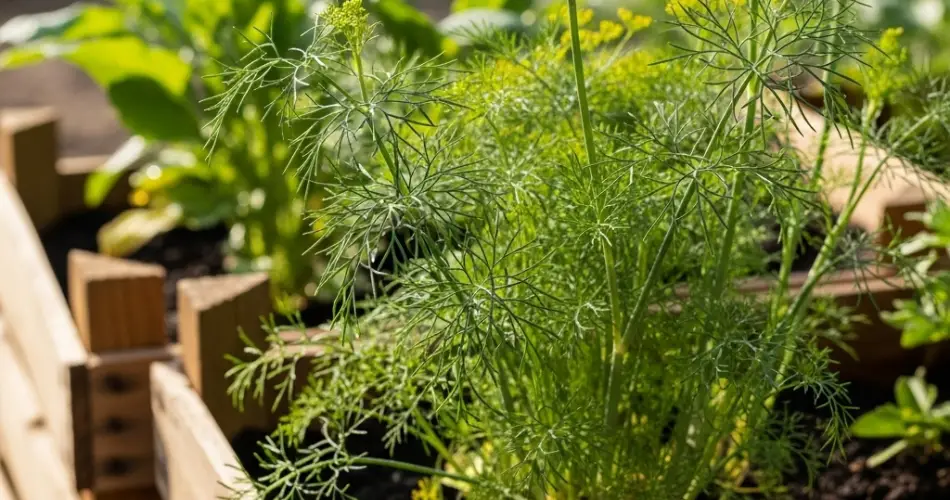Dill is an aromatic herb cherished for its delicate, feathery leaves and versatile culinary uses. From flavoring salads, sauces, and soups to adding a unique touch to pickles, dill enhances a wide range of dishes. For apartment dwellers and urban gardeners with limited space, crate gardening offers an effective way to cultivate fresh, flavorful dill right on a balcony, terrace, or windowsill. This guide outlines how to grow, maintain, and harvest dill in crate planters to ensure a productive and convenient herb supply.
Choosing the Right Crate
Selecting the proper container is the foundation of a successful crate garden. Wooden crates are a popular choice because they are sturdy, breathable, and visually appealing. Recycled or repurposed crates are ideal for sustainable gardening while adding rustic charm to your balcony. The crate should be deep enough to accommodate dill’s taproot, ideally 25–30 cm (10–12 inches), and provide ample space for multiple plants. Drainage is essential; ensure the crate has multiple holes at the bottom to prevent water accumulation, which can cause root rot.
Preparing the Soil
Dill grows best in light, well-draining soil that is moderately fertile. A suitable soil mix combines high-quality potting soil with perlite or coarse sand to enhance drainage and prevent compaction. Adding a small amount of organic compost enriches the soil with nutrients, promoting strong growth and flavorful leaves. Avoid heavy or clay soils that retain too much moisture, as this can lead to root problems and poor plant health. A balanced soil mix lays the foundation for vigorous, aromatic dill plants.
Planting Dill
Dill can be grown from seeds, seedlings, or divisions, with seeds being the most common and convenient method. Sow seeds directly into the soil, spacing them 5–7 cm apart for proper airflow. Lightly cover the seeds with soil and water gently to avoid displacing them. Germination typically occurs within 7–10 days. Once seedlings develop a few sets of leaves, thin them to maintain spacing of 15–20 cm, ensuring each plant has room to grow and thrive.
Positioning the Crate
Dill prefers full sun for optimal growth, ideally receiving 6–8 hours of sunlight per day. Position your crate in a bright location on your balcony or terrace, where the plants can receive ample light without being exposed to extreme afternoon heat. Proper sunlight encourages strong stems, flavorful leaves, and healthy seed development. If sunlight is limited, reflective surfaces or supplemental grow lights can help maintain consistent growth. Adequate airflow around the crate is also essential to prevent fungal diseases.
Watering and Fertilizing
Dill requires consistent moisture but does not tolerate waterlogged soil. Water the plants at the base, keeping leaves dry to minimize fungal issues. Overwatering can lead to root rot, while underwatering may stunt growth and reduce flavor. Fertilize sparingly every 3–4 weeks with a balanced, slow-release fertilizer or organic alternatives such as compost tea. Avoid over-fertilization, which can lead to leggy growth and reduced leaf quality.
Supporting Dill Plants
Dill can grow tall, often reaching 60–120 cm (2–4 feet), and may require support to prevent bending or toppling. Use bamboo stakes, small trellises, or lightweight plant supports in the crate, and gently tie stems as they grow. Supporting the plants helps maintain upright growth, improves airflow, and simplifies harvesting. Proper support is particularly important in balcony gardens exposed to wind or limited space.
Pruning and Maintenance
Regular maintenance keeps dill healthy and productive. Remove yellow or damaged leaves to encourage new growth and prevent disease. Pinching off flower heads early can extend the leaf-harvesting period, as flowering shifts the plant’s energy from foliage to seed production. Mulching with a thin layer of organic material can help retain soil moisture, regulate temperature, and suppress weeds. Occasional checks for pests, such as aphids, are recommended, with organic treatments applied if needed.
Harvesting Dill
Leaves can be harvested once plants reach 15–20 cm in height. Cut outer leaves first, leaving sufficient foliage for continued growth. For seeds, allow flower heads to mature and dry before collecting. Frequent harvesting encourages bushier growth and ensures a steady supply of fresh dill for cooking. Leaves can be used fresh, dried, or frozen, while seeds can be stored for later use in pickling and seasoning.
Benefits of Crate Gardening Dill
Growing dill in crates offers numerous advantages for apartment cooks. It maximizes small-space efficiency, allowing fresh herbs in urban settings. Crates are portable, making it easy to adjust sunlight exposure or protect plants from harsh weather. Using repurposed crates promotes sustainability while adding rustic charm to your balcony. Fresh dill grown in crates enhances culinary creations, provides aromatic foliage, and creates a vibrant, productive outdoor space.
By following these tips, urban gardeners can cultivate healthy, flavorful dill in crate planters, transforming small balconies or terraces into productive herb gardens. With proper soil, sunlight, watering, and support, crate-grown dill provides a continuous supply of fresh leaves and seeds, making it a convenient and rewarding addition to any apartment kitchen.



